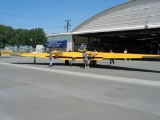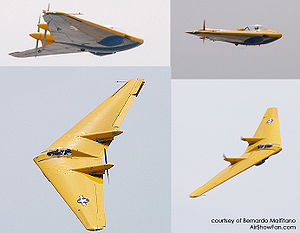
Northrop N-9M
Encyclopedia
The Northrop N-9M was a one-third scale aircraft used for the development of the Northrop XB-35 and YB-35 Flying Wing
Flying wing
A flying wing is a tailless fixed-wing aircraft which has no definite fuselage, with most of the crew, payload and equipment being housed inside the main wing structure....
long-range bomber program. First flown in 1942, the N-9M (M for Model) was the third in a lineage of all-wing Northrop aircraft designs that began in 1929 when Jack Northrop
John Knudsen Northrop
John Knudsen "Jack" Northrop was an American aircraft industrialist and designer, who founded the Northrop Corporation in 1939.-Entering aviation:...
succeeded in early experiments with his single-prop, twin-tailed, stressed metal skin Northrop Flying Wing monoplane, and a decade later, the dual-prop N-1M
Northrop N-1M
|-See also:-References:NotesCitationsBibliography* Coleman, Ted. Jack Northrop and the Flying Wing: The Real Story Behind the Stealth Bomber. New York: Paragon House, 1988. ISBN 1-55778-079-X....
of 1939–1941. Northrop's pioneering all-wing aircraft would lead Northrop-Grumman many years later to eventually develop the advanced B-2 Spirit
B-2 Spirit
The Northrop Grumman B-2 Spirit is an American heavy bomber with low observable stealth technology designed to penetrate dense anti-aircraft defenses and deploy both conventional and nuclear weapons. The bomber has a crew of two and can drop up to eighty -class JDAM GPS-guided bombs, or sixteen ...
stealth bomber, which debuted in Air Force
Air force
An air force, also known in some countries as an air army, is in the broadest sense, the national military organization that primarily conducts aerial warfare. More specifically, it is the branch of a nation's armed services that is responsible for aerial warfare as distinct from an army, navy or...
inventory in 1989.
Design and development
On 30 October 1941, the preliminary order for development of the B-35 Flying Wing bomber was confirmed, including engineering, testing, and - most importantly - a 60 ft (18 m) wingspan, one-third scale aircraft, designated N-9M. It was to be used in gathering data on flight performance and for familiarizing pilots with the program's radical, all-wing design. The first N-9M was ordered in the original contract, but this was later expanded to three test aircraft in early 1943. A fourth was ordered a few months later and would incorporate flight test improvements, including different, more powerful engines. They were designated N-9M-1, -2, -A, and -B, respectively.The N-9M framework was partially constructed of wood to reduce its overall weight. The wings' outer surfaces were also skinned in a strong laminated plywood
Plywood
Plywood is a type of manufactured timber made from thin sheets of wood veneer. It is one of the most widely used wood products. It is flexible, inexpensive, workable, re-usable, and can usually be locally manufactured...
. The central section (roughly equivalent to the fuselage
Fuselage
The fuselage is an aircraft's main body section that holds crew and passengers or cargo. In single-engine aircraft it will usually contain an engine, although in some amphibious aircraft the single engine is mounted on a pylon attached to the fuselage which in turn is used as a floating hull...
) was made of tubular steel. The aircraft were originally powered by two Menasco C6S-1 inverted air-cooled straight-six engines, driving twin-bladed propeller
Propeller (aircraft)
Aircraft propellers or airscrews convert rotary motion from piston engines or turboprops to provide propulsive force. They may be fixed or variable pitch. Early aircraft propellers were carved by hand from solid or laminated wood with later propellers being constructed from metal...
s. The original engines were 290 hp (216 ); the N-9MB later upgraded to 400 hp (298 kW) Franklin
Franklin Engine Company
The Franklin Engine Company was a manufacturer of aircraft engines, formed as the H. H. Franklin Co. in 1902, located in Syracuse, New York, United States. Barely surviving bankruptcy in 1933, the company was purchased by a group of ex-employees and renamed Aircooled Motors in 1937...
engines.
Operational history
The first flight of the N-9M occurred on 27 December 1942 with Northrop test pilot John Myers at the controls. During the next five months, 45 flights were made. Nearly all were terminated by mechanical failures of one sort or another, the Menasco engines being the primary source of those problems. After roughly 22.5 hours of accumulated flight time, the first N-9M crashed approximately 12 miles (19 km) west of Muroc Army Air Base on 19 May 1943. The pilot, Max Constant, was killed as he attempted to recover the aircraft from a right-hand, 60° nose-down spin. The investigation found that Constant had suffered control reversal, the control column had been pressed against his chest during his recovery attempt from the steep spin, preventing him for parachuting to safety. Steps were taken to fix this problem and prevent it from happening on other N-9M test aircraft.When Northrop's Flying Wing bomber program was canceled, all remaining N-9M flight test aircraft, except for the final N-9MB, were scrapped. For more than three decades, it slowly deteriorated until the Chino, California
Chino, California
Chino is a city in San Bernardino County, California, United States. It is located in the western end of the Riverside-San Bernardino Area and it is easily accessible via the Chino Valley and Pomona freeways....
Planes of Fame
Planes of Fame
Planes of Fame Air Museum is an aviation museum located in Chino, California, and Valle, Arizona. The museum has many flying and static aircraft, along with multiple rare examples under restoration.-History:...
Air Museum acquired the aircraft in 1982 and began the labor-intensive restoration process. For the next two decades, former Northrop employees and other skilled volunteers slowly returned the N-9MB to its final flight configuation. Since 2001, the yellow-and-blue Flying Wing has been exhibited, with flight demonstrations at several airshows every year.
In April 2006, the N-9MB suffered an in-flight engine fire. The aircraft was landed safely with limited damage. Donations to the museum were solicited for its repair, and the aircraft was fully repaired to flight status. It was once again flown during the annual Chino airshow on 15–16 May 2010.

Specifications (N-9M)
See also
Related development:- Northrop N-1MNorthrop N-1M|-See also:-References:NotesCitationsBibliography* Coleman, Ted. Jack Northrop and the Flying Wing: The Real Story Behind the Stealth Bomber. New York: Paragon House, 1988. ISBN 1-55778-079-X....
- Northrop YB-35Northrop YB-35The Northrop XB-35 and YB-35 were experimental heavy bomber aircraft developed for the United States Army Air Forces during and shortly after World War II by the Northrop Corporation. It used the radical and potentially very efficient flying wing design, in which the tail section and fuselage are...
- Northrop YB-49Northrop YB-49The Northrop YB-49 was a prototype jet-powered heavy bomber aircraft developed by Northrop shortly after World War II. Intended for service with the U.S. Air Force, the YB-49 featured a flying wing design...
Comparable aircraft:
- Horten H.VII
- Horten Ho 229Horten Ho 229The Horten H.IX, RLM designation Ho 229 was a late–World War II prototype fighter/bomber designed by Reimar and Walter Horten and built by Gothaer Waggonfabrik...
- Armstrong Whitworth A.W.52Armstrong Whitworth A.W.52-See also:- External links :*** at *...

